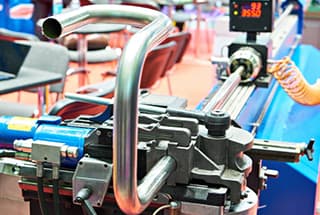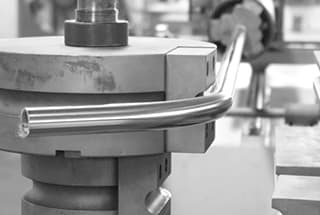
Ever wondered how intricate pipe shapes are crafted with precision? This guide unveils the secrets of pipe benders, exploring their types, mechanisms, and applications. With insights from seasoned mechanical engineers, discover the innovations revolutionizing industries and learn how to choose the right bender for your needs.
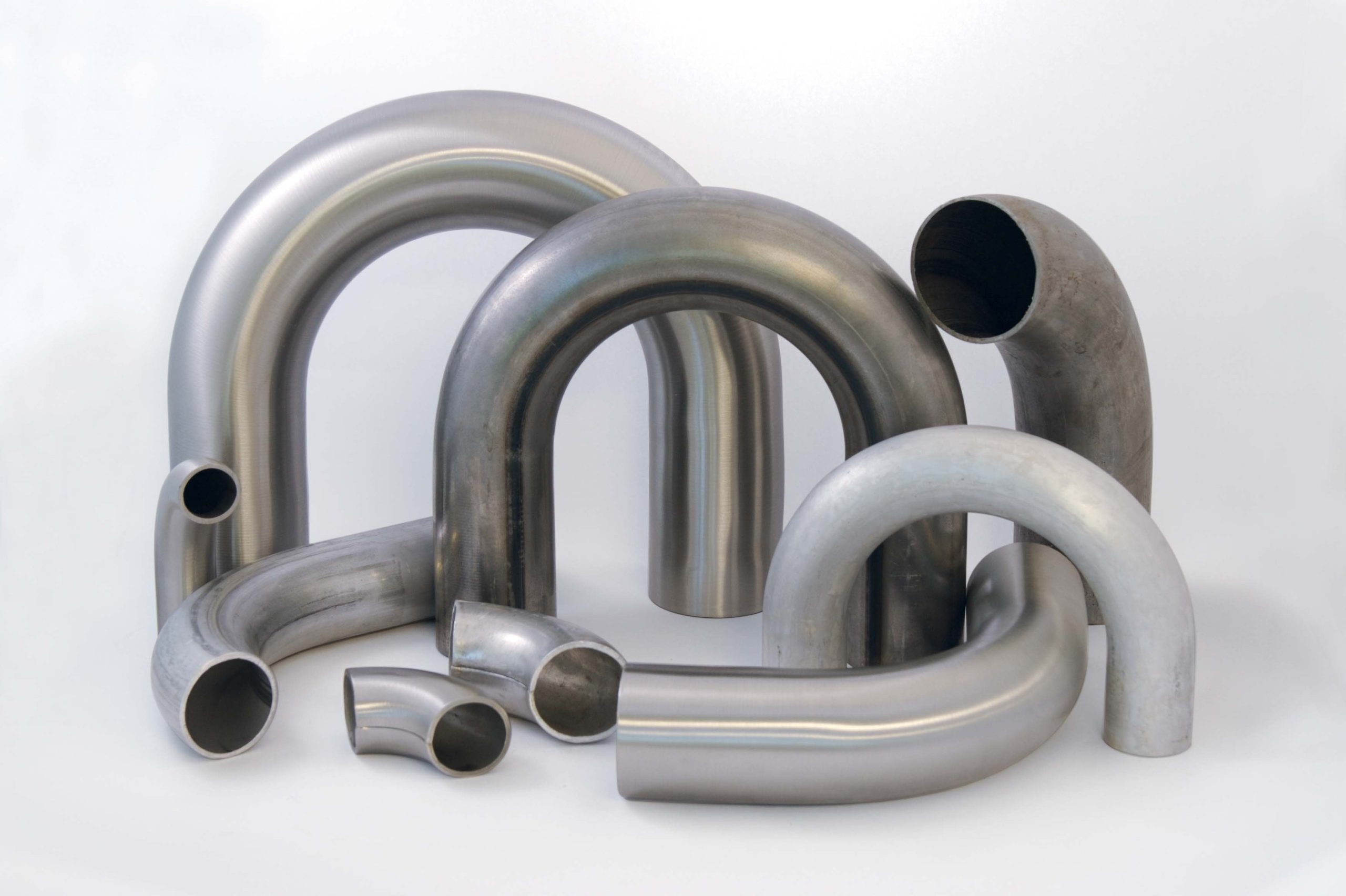
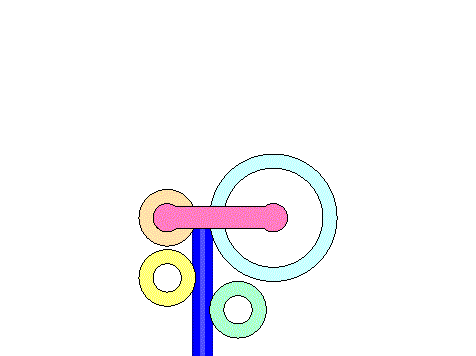
A pipe bender is a specialized machine designed for precision bending of tubular materials, primarily categorized into computer numerical control (CNC) and hydraulic systems. These versatile machines play a crucial role in various industrial sectors, including power generation, transportation infrastructure, structural engineering, marine construction, and numerous other applications requiring curved or shaped piping.
In contrast to plate bending machines, which are engineered for flat sheet metal forming, pipe benders are specifically optimized for manipulating cylindrical steel pipes and tubes. Their application spectrum spans across critical industries such as power plant construction, railway and highway development, boiler manufacturing, bridge building, shipyard operations, architectural metalwork, and custom furniture fabrication. Additionally, they are indispensable in complex pipeline installations and building services where precise pipe routing is essential.
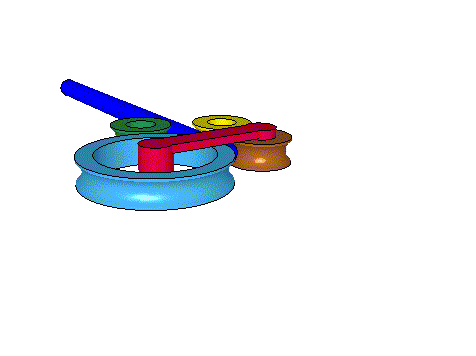
Within the tubing machinery sector, pipe benders are recognized as cornerstone equipment due to their multifaceted capabilities. Modern pipe benders incorporate advanced features such as programmable bend sequences, multi-axis control for complex geometries, and integrated measurement systems for enhanced accuracy. Their well-engineered design typically includes robust frames to withstand high bending forces, precision mandrels to maintain pipe integrity during forming, and sophisticated hydraulic or servo-electric drive systems for precise control.
The user-friendly interface and ergonomic design of contemporary pipe benders facilitate efficient operation, allowing for rapid setup and reduced cycle times. This combination of versatility, precision, and ease of use makes pipe benders an invaluable asset in metal fabrication processes, enabling manufacturers to meet increasingly demanding specifications in terms of bend accuracy, repeatability, and surface finish quality.
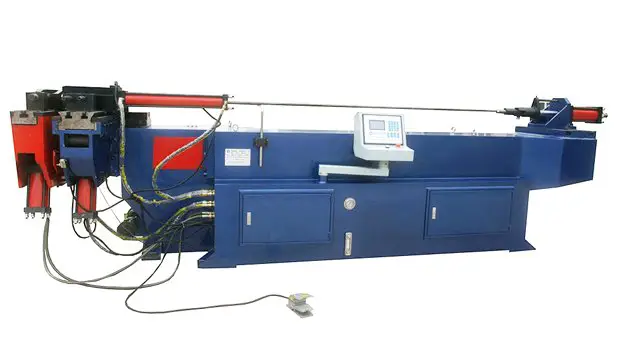
A pipe bending machine, also known as a tube bender, is a specialized piece of equipment designed to precisely form pipes and tubes into various shapes, angles, and curves. These machines are capable of manipulating a wide range of materials, including carbon steel, stainless steel, aluminum alloys, copper, and even exotic alloys, with diameters typically ranging from 1/4 inch to 20 inches or more.
Pipe benders can be broadly categorized into two main types:
Modern pipe bending machines often incorporate features such as mandrel bending (to prevent pipe collapse), boost bending (for tight radius bends), and multi-stack tooling for quick changeovers between different pipe sizes.
The versatility and efficiency of pipe benders make them indispensable in numerous industries, including:
Key advantages of advanced pipe bending machines include:
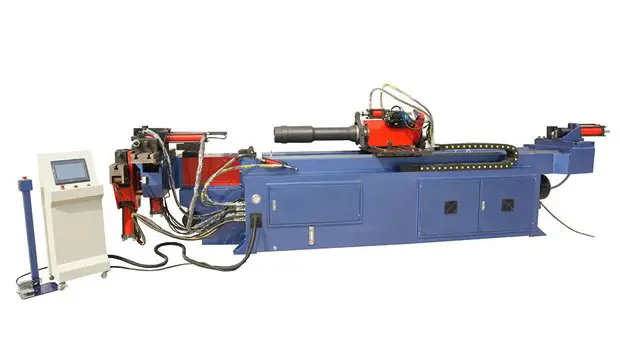
Pipe benders are sophisticated machines designed to shape pipes into various configurations, including I-beams, channel steels, angle irons, and wires. These versatile tools can produce a wide range of forms such as coils, U-shaped pipes, half pipes, and helical coils. The main categories of pipe benders include hydraulic electric bending machines, horizontal hydraulic pipe benders, and multi-functional rolling pipe benders.
Electric pipe benders utilize an electric motor as their power source, with the bending force transmitted through a speed reducer and gear chain mechanism. In contrast, hydraulic pipe benders employ hydraulic pressure to execute a series of precise movements: driving the clamping mechanism, retracting the bending die, performing the pipe bend, and controlling the mandrel’s forward and backward auxiliary movements.
Hydraulic pipe benders are widely used for planar winding operations and offer several advantages, including multi-functionality, ergonomic design, ease of operation, portability, and rapid setup. These machines find applications across various industries, including electric power infrastructure, highway and railway construction, boiler manufacturing, bridge building, shipbuilding, furniture production, and architectural decoration.
CNC (Computer Numerical Control) pipe benders represent a significant technological advancement over traditional hydraulic systems. These machines employ servo motors instead of hydraulic power, enabling precise control over multiple axes of movement: material feeding and retraction, rotation of the bending plane, bending and springback compensation, auxiliary movements, and bending head positioning. The key differentiators of CNC pipe benders are their capacity for continuous production, superior processing precision, and ability to create complex three-dimensional pipe formations.
Numerical control pipe benders excel in cold-state bending operations, capable of producing bends with one or two radii in a single setup. Their versatility makes them indispensable in industries such as automotive manufacturing and HVAC system production, where they are used to fabricate a wide array of pipe fittings and wire forms.
Pipe bending methods can be broadly classified into two categories:
Each type of pipe bender offers unique capabilities and is selected based on factors such as material properties, required bend complexity, production volume, and industry-specific standards.
According to the method of pipe bending, it can be divided into push bending, roll bending, press bending, and circle bending. Of these, circle bending is relatively easy to automate, so currently, bending machines are mostly designed for this method. The bending process principle is illustrated in a diagram.
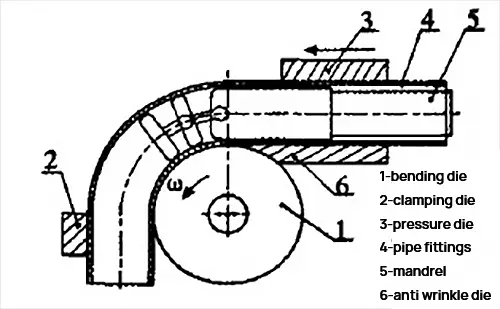
The bending process is performed using a bending die, clamping die, and pressure die. The bending die is mounted on the spindle, while the clamping die secures the pipe fittings to prevent any axial movement. The pressure die consists of a guide die and a follow-up die. During the bending process, the guide die applies the appropriate pressure on the anti-wrinkle die to the pipe fittings, and the follow-up die moves along with the pipe fittings. A mandrel is also used to fill the inner cavity of the workpiece and prevent any wrinkles, flattening, thinning or other failures during bending.
The spindle rotates and the tube is formed by being wound around the bending die. The process also involves feeding the workpiece, preparing the space for the next bend, and so on. The bending radius is determined by the radius of the bending die, and different bending radii can be achieved by simply replacing the bending die with one of a different radius.
Structure and working principle of automatic pipe bender and electro-hydraulic pipe bender:
The hydraulic system of a pipe bender is composed of an electric oil pump, high-pressure oil pipes, quick connectors, working cylinder, and plunger. The elbow part of the machine includes an upper flower plate, lower flower plate, die head, and roller. The electric oil pump outputs high-pressure oil, which is sent to the working cylinder through high-pressure oil pipes. The high-pressure oil drives the plunger in the working cylinder to generate thrust, resulting in bending through the elbow component.
The Pipe Bender incorporates advanced CNC technology with a user-friendly touchscreen interface, enabling precise numerical control and intuitive program setting through a dialogue-based operation system. Its robust structural design ensures high rigidity and dimensional stability during the bending process.
The machine’s memory capacity allows for storage of 16 distinct bending programs, each capable of accommodating up to 16 unique bending angles. This versatility facilitates complex multi-bend operations without reprogramming. The integrated slow-speed positioning function, coupled with a high-precision angle control system, delivers exceptional repeatability with a tolerance of ±0.1°, ensuring consistent quality across production runs.
To enhance operational efficiency and minimize downtime, the Pipe Bender features a real-time error detection and display system. Any deviations or malfunctions are immediately communicated via on-screen messages, enabling operators to swiftly identify and resolve issues, thereby maintaining optimal productivity.
Complementing the machine’s hardware capabilities is an optional CAD/CAM software package. This powerful tool translates complex pipe geometries into machine-readable coordinates, streamlining the transition from design to production. The software can be installed on standard desktop computers, offering flexibility in offline programming, bend sequence optimization, and springback compensation calculations.
The Pipe Bender operates on a hydraulic principle, utilizing high-pressure oil from an electric pump to generate the necessary force for bending. This pressurized oil is channeled through high-pressure lines into the working cylinder, where it drives a plunger to produce the thrust required for pipe deformation.
Key advantages of modern Pipe Benders include:
While the advantages are numerous, potential limitations may include initial capital investment, space requirements for larger models, and the need for specialized training for optimal utilization. However, these factors are often outweighed by the significant improvements in productivity, quality, and versatility that modern pipe bending machines offer.
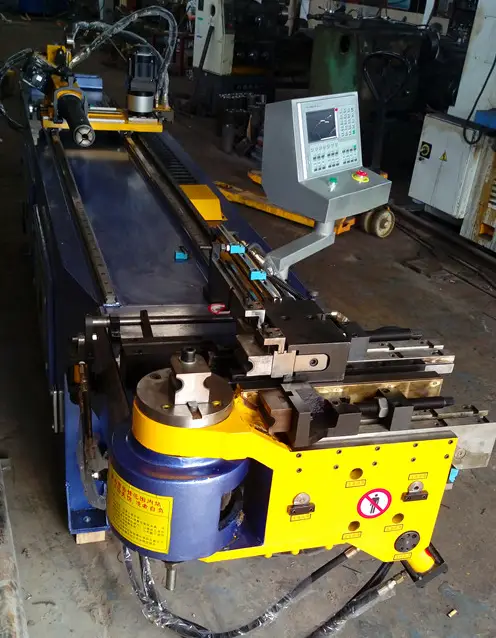
The pipe bending machine is a crucial tool in various industries, yet many are unfamiliar with its intricate components. Let’s explore the key elements that make up this versatile equipment:
Fully Automatic Bed:
The bed serves as the foundation of the machine, featuring a robust frame constructed from welded channel steel. The spindle’s upper and lower bearing support plates are mounted on a high-strength steel plate frame, typically 15mm thick, ensuring stability and precision during operation.
Hydraulic System Component:
The hydraulic system can be equipped with either industrial-grade commercial accessories or high-performance aircraft hydraulic components, depending on the required precision and application. This system provides the necessary force for bending operations and ensures smooth, controlled movements.
Transmission Component:
This assembly comprises several critical elements:
These components work in synergy to execute precise bending movements.
Mold Component:
The mold, or die, is a crucial tool in shaping the pipe. It’s typically fabricated from high-grade materials such as bearing steel or alloy steel, selected based on the pipe’s surface diameter and required bend characteristics. The mold undergoes heat treatment to achieve a hardness of HRC48~52, ensuring durability and maintaining dimensional stability under high stress.
Clamping Component:
The hydraulic clamping mechanism consists of:
The expansion and contraction of the hydraulic cylinder actuate the rocker arm, enabling secure and precise pipe holding during the bending process.
Electrical Components:
These components control and automate the bending process, including motors, sensors, programmable logic controllers (PLCs), and user interface systems. They enable precise control over bending parameters, ensuring consistency and efficiency in production.
The pipe bender, a specialized machine for forming curved sections in tubular materials, shares operational principles with sheet bending equipment but is optimized for cylindrical workpieces.
When a pipe undergoes pure bending under an applied external torque M, a complex stress distribution develops across its cross-section. The outer wall beyond the neutral axis experiences tensile stress σ1, resulting in wall thinning, while the inner wall experiences compressive stress σ2, leading to wall thickening. This stress gradient is critical in understanding the pipe’s behavior during bending.
The combined effect of these opposing forces (F1 and F2) causes the pipe’s cross-section to deform from circular to approximately elliptical. This ovalization is a key consideration in pipe bending. If the deformation exceeds the material’s elastic limit, it can lead to structural defects: tensile stress may induce cracking on the outer wall, while compressive stress may cause wrinkling or buckling on the inner wall.
The extent of pipe deformation is primarily governed by two dimensionless parameters:
As these ratios decrease, the degree of deformation increases. Typically, smaller R/D values result in tighter bends but also higher stress concentrations and greater risk of defects.
To ensure the structural integrity and quality of bent pipe fittings, it is crucial to control the deformation within acceptable limits defined by industry standards (e.g., ASME B31.3 for process piping). The bending capacity of a pipe is influenced by multiple factors:
Advanced pipe bending operations often employ mandrels, wiper dies, or pressure dies to maintain cross-sectional integrity and minimize wall thinning. Additionally, computer numerical control (CNC) systems enable precise control of bending parameters, ensuring repeatability and optimizing the process for various pipe materials and geometries.
The forming limits of pipe fittings must be carefully considered to ensure structural integrity and functionality. These limits encompass several critical factors:
The rocker arm ensures precise control of the pipe’s bending radius, adhering to specified tolerances. It works in tandem with the clamping seat, which mitigates elastic rebound of the steel pipe during the bending process, enhancing dimensional accuracy.
The hydraulic system comprises dual pressure stages: high-pressure for force-intensive operations and low-pressure for auxiliary functions. This bifurcated system efficiently powers the guiding roller, rocker arm clamp seat, hydraulic cylinder, push device, trolley carriage, and straightening roller, optimizing energy utilization and control precision.
The Guide Roller Device incorporates two sets of guiding rollers, a robust frame, and a precision clamping transmission system. Hydraulically actuated, the guide rollers’ opening and closing mechanisms synchronize with the rocker arm to maintain the steel pipe’s horizontal alignment throughout the bending process, ensuring consistent curvature.
The Driving Device serves as the primary power source for the push mechanism, utilizing either electric or hydraulic systems depending on the required force and control characteristics.
The Straightening Roller employs a multi-axis adjustment system to counteract vertical deformation during bending. Working in conjunction with a floating anti-ellipse fixture, it maintains the pipe’s circular cross-section within specified tolerances, preventing ovalization and ensuring structural integrity.
The Push Device, an integrated system comprising a carriage, bed, transmission shaft, and traction chain, advances the steel pipe at a controlled rate. This coordinated movement, in concert with the rocker arm and guide roller, facilitates precise, continuous bending while minimizing material stress and deformation.
(1) Thoroughly review the electric pump manual before operation.
(2) Begin by securely threading the working cylinder into the square block’s inner thread. Ensure the cylinder’s rear end is properly seated on the support wheel for stability during operation.
(3) Select the appropriate die head based on the pipe diameter. Install it in the plunger, aligning the two rollers with their corresponding grooves facing the die head. Insert the correctly sized mandrel into the designated hole and cover it with the upper mandrel. Carefully place the pipe into the groove. Connect the high-pressure tubing by retracting the quick-connect coupling’s active end and attaching it to the work cylinder connector. Before initiating the bending process, verify that the oil release screws on the electric oil pump are fully tightened.
Upon completing the bending operation, gradually loosen the oil release screw to allow the plunger to reset automatically.
Important Remarks:
(1) Adhere strictly to the electric pump manual for safe and efficient operation.
(2) Never attempt to disconnect the quick connector while the system is under load, as this may result in sudden pressure release and potential injury.
(3) The machine utilizes hydraulic oil as its working medium. Regular and thorough cleaning and maintenance of both the oil and pipe bender components are crucial. This prevents blockages, leaks, and contamination, which could significantly impact the machine’s performance and longevity.
Electrohydraulic (Electric Pipe Bender) Applications:
This versatile automatic pipe bender is ideal for pipe installation and maintenance across various industrial and commercial settings, including:
Additional Functionality:
The pipe bending component (hydraulic cylinder) can be detached and repurposed as a standalone hydraulic pipe jacking machine, offering enhanced versatility for specialized applications.
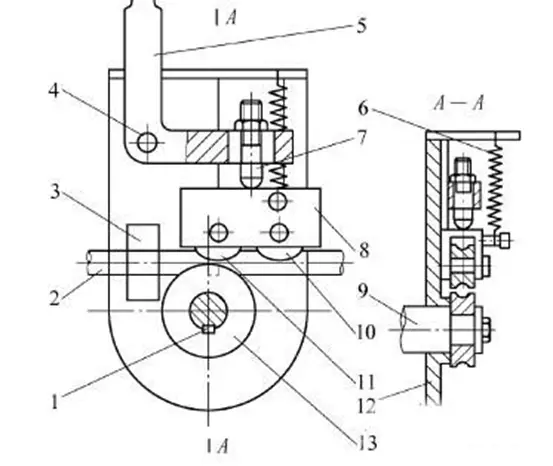
(1) BENDING DIE
Installation:
(2) CLAMP DIE
Installation:
Adjustment:
A. Secure and release the clamping seat, then set the control panel to manual mode. Press the clamp button to the end of the clamping path. (At this point, there should be a gap between the wheel clamping die, which can be adjusted using the clamping seat adjustment screw).
B. Adjust the clamping seat adjustment screw so that the clamping die and bending die are fully sealed.
C. Press the back button to retract the clamping die, then adjust the clamping screw by rotating it approximately 1/2 to 1/4 circle in a clockwise direction.
D. Finally, lock the fixed nut on the clamping seat.
(3) Pressure DIE
Installation:
A, remove the fixed screw on the pressure die and then put the pressure die in.
B, lock the guide mold screws.
Adjustment:
A. Secure and release the clamping seat, then set the control panel to manual mode. Press the clamp button to the end of the clamping path. (At this point, there should be a gap between the wheel clamping die, which can be adjusted using the clamping seat adjustment screw).
B. Adjust the clamping seat adjustment screw so that the clamping die and bending die are fully sealed.
C. Press the back button to retract the clamping die, then adjust the clamping screw by rotating it approximately 1/2 to 1/4 circle in a clockwise direction.
D. Finally, lock the fixed nut on the clamping seat.
(4) Mandrel
Installation:
A. put the mandrel into the core rod in the clockwise direction.
B. then fix the screws of the mandrel.
(Please note that the mandrel must be in the direction of bending)
The machine tool must be properly grounded using a flexible copper cord with a minimum cross-sectional area of 4mm². The power supply voltage must remain within the specified range. Avoid testing the control circuit with a megger (insulation tester), as this may damage sensitive electronic components.
When connecting or disconnecting electrical connectors, always grip the connector body rather than pulling on wires or cables to prevent solder joint failure or wire breakage.
Protect limit switches, encoders, and other precision components from impact with hard objects to maintain their accuracy and functionality.
Shield the display unit from sharp objects to prevent screen damage and ensure clear visibility of critical information.
Install the electrical control cabinet in a well-ventilated area, away from dusty environments or corrosive atmospheres that could compromise electronic components.
Refrain from modifying PC input/output terminals to maintain system integrity and prevent potential malfunctions or safety hazards.
When altering the machine tool’s power supply, reconfirm motor specifications to ensure compatibility and optimal performance.
Maintain cleanliness of the machine, paying particular attention to the clamping block and sliding block. Regularly inspect and remove any debris or foreign objects that could impair precision or cause wear.
Implement a regular lubrication schedule for the chain and all sliding parts, using appropriate lubricants to minimize friction and extend component life.
Always disconnect the power supply before performing any cleaning or maintenance tasks to ensure operator safety.
Preparation: Prior to operation, perform the following checks:
Pressure Adjustment: Utilize the electromagnetic relief valve to set the system pressure to the required working pressure, typically not exceeding 12.5 MPa. This ensures optimal bending force while protecting system components.
Mold Adjustment: Proper alignment is crucial for precision bending:
These precise alignments minimize wear, ensure consistent bend quality, and extend tool life.
When operating the pipe bending machine, ensure that the rotating arm’s sweep area is clear of all personnel. Strictly prohibit anyone from entering the vicinity of the rotating arm and pipe fittings during machine operation to prevent potential injuries.
The hydraulic system of the pipe bender utilizes YA-N32 standard hydraulic oil (ISO VG 32). Perform annual oil changes and concurrent filter cleaning to maintain optimal system performance and longevity.
Only authorized and trained personnel should make adjustments to the pipe bender or dies. To ensure safety, adjustments must be carried out by a minimum of two operators, with one stationed at the control cabinet to monitor operations and provide immediate assistance if needed.
Prior to any adjustments or when operating the machine without a workpiece, remove the mandrel to prevent potential damage or misalignment.
Maintain the hydraulic system pressure below the maximum threshold of 14 MPa (2030 psi) to prevent system damage and ensure safe operation.
When manually adjusting cylinder speed, rotate the arm beyond 90 degrees. Synchronize the adjustment speed with the linear velocity of the rotary elbow’s edge. Never exceed this speed in manual mode, as it may lead to loss of control and potential equipment damage.
Conduct regular inspections of chain tension, ensuring consistent elasticity over time. Proper chain maintenance is crucial for precise bending operations and extended machine life.
In automatic core bending mode, before retracting the former bend arm, verify that the core head is properly positioned within the pipe and that the core shaft is unobstructed. Failure to do so may result in bending or breakage of the core head or rod.
After each use, disconnect the power supply and perform thorough cleaning and lubrication of the machine. This practice helps maintain optimal performance, prolongs equipment lifespan, and ensures readiness for subsequent operations.
Design exhaust pipes to minimize complex geometries, focusing on standardized bends and efficient manufacturing processes. Avoid large circular arcs, arbitrary curves, and composite bends exceeding 180°.
Large circular arcs increase production complexity and are constrained by tube bender capacities. They often require specialized equipment or multi-step processes, reducing overall manufacturing efficiency and increasing costs.
Arbitrary curves and composite bends hinder mechanization and automation efforts. These irregular shapes often necessitate manual fabrication, impeding the implementation of advanced manufacturing techniques such as CNC bending or robotic welding. This reliance on manual labor not only increases production time but also exposes operators to ergonomic risks associated with repetitive motions and heavy lifting.
Bends exceeding 180° present significant challenges in the pipe bending process. Most standard tube benders cannot effectively form or release such extreme angles due to mechanical limitations. These bends often require segmented fabrication or specialized tooling, leading to increased production complexity, potential quality issues at joint points, and higher manufacturing costs.
To optimize exhaust pipe design for manufacturability:
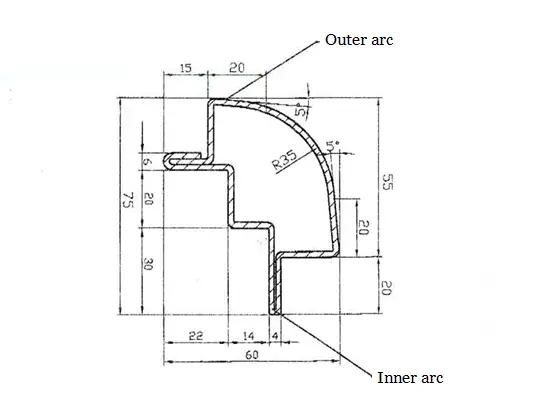
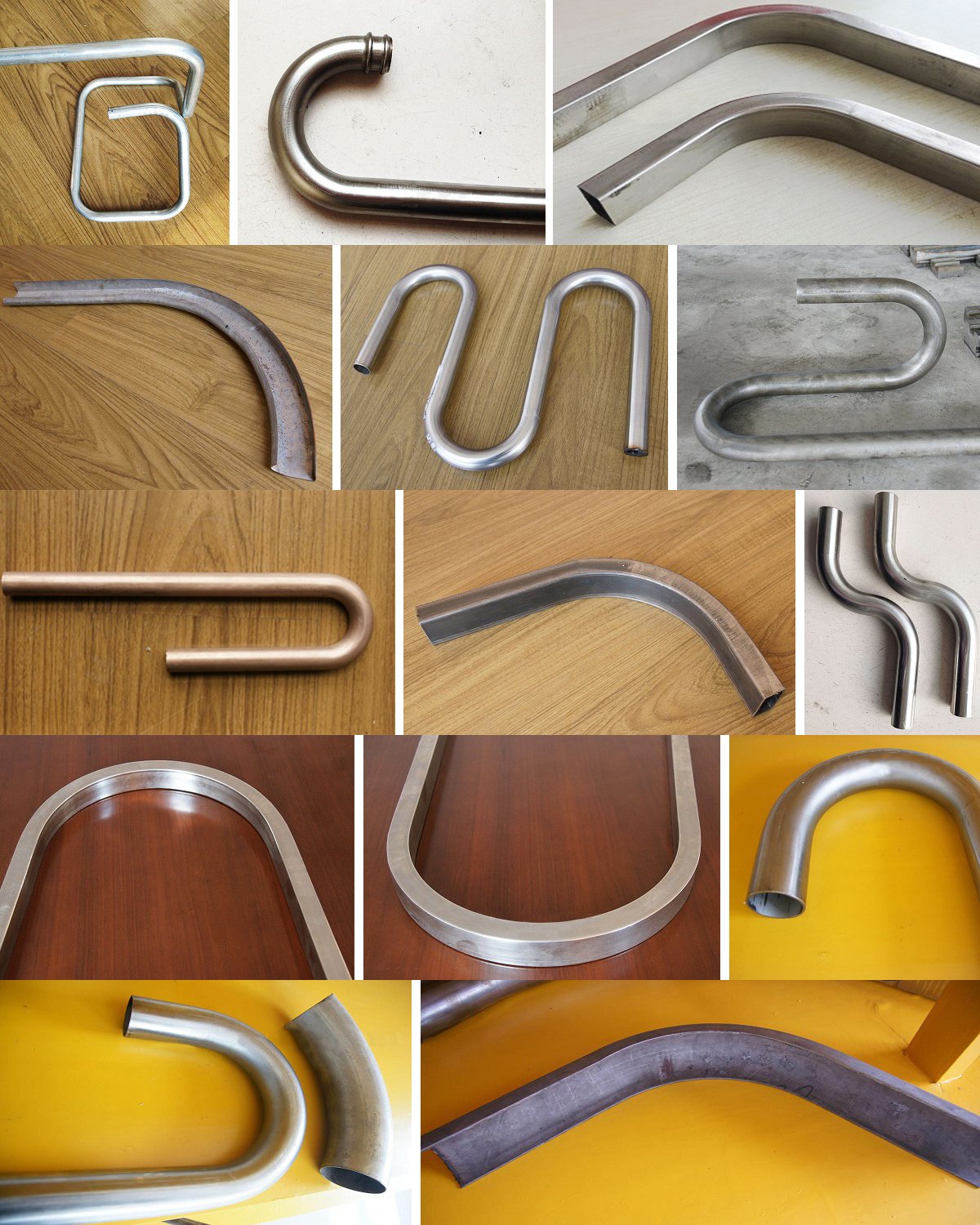
The bending speed in pipe forming processes significantly impacts the quality of the final product. Optimizing this parameter is crucial for achieving desired results and avoiding common defects. The effects of bending velocity on forming quality can be summarized as follows:
Excessive Speed:
Insufficient Speed:
To determine the optimal bending speed, it is recommended to set the final bending velocity at 20-40% of the machine’s maximum capacity. This range provides a balance between productivity and quality, allowing for:
Factors influencing the specific speed selection within this range include:
It’s important to note that these guidelines may vary slightly depending on the specific pipe bending machine, material, and application. Conducting trials and fine-tuning the process parameters for each unique setup is essential for achieving optimal results in pipe bending operations.
The selection of an optimal bending radius is crucial in pipe bending operations, balancing the principles of “one pipe, one die” and “multiple pipes, one die” to maximize efficiency and versatility.
In scenarios where a pipe requires only a few bending positions or angles, a single bending radius is typically employed. This approach, known as “one pipe, one die,” is necessitated by the mechanical constraints of pipe bending machines, which cannot alter their bending module mid-process. This method ensures precision for specific pipe configurations but may limit flexibility.
Conversely, the “multiple pipes, one die” approach offers greater versatility and cost-effectiveness. This strategy involves standardizing the bending radius for pipes of identical diameters, regardless of their final shape. By utilizing the same bending modules for various pipe configurations, this method significantly reduces the inventory of required tooling. This standardization not only streamlines production but also minimizes setup times and tooling costs.
The selection between these approaches depends on factors such as production volume, variety of pipe designs, and available resources. For high-volume production of standardized parts, the “multiple pipes, one die” method often proves more efficient. However, for specialized or low-volume applications, the “one pipe, one die” approach may be more suitable.
Importantly, when implementing the “multiple pipes, one die” strategy, careful consideration must be given to material properties, wall thickness, and bend quality requirements to ensure that a single radius can adequately serve multiple pipe designs without compromising structural integrity or performance.
In the pipe bending process, a mandrel serves as a critical internal support mechanism to maintain the structural integrity of the pipe’s inner wall at the bending radius, effectively preventing deformation and ovalization. Without the implementation of a mandrel, ensuring consistent quality and dimensional accuracy in pipe bending operations becomes significantly challenging, particularly for thin-walled pipes or those requiring tight bend radii.
Mandrels come in various configurations, each designed to address specific bending requirements:
1. Cylindrical mandrels: Suitable for simple bends in thick-walled pipes
2. Universal mandrels:
3. Orientation mandrels:
These designs allow for flexibility in accommodating different pipe diameters, wall thicknesses, and bend complexities.
The precise positioning of the mandrel within the pipe during the forming process plays a crucial role in achieving optimal bending results. Theoretically, the tangent point of the mandrel should align with the tangent point of the pipe bending die. However, extensive empirical studies have demonstrated that advancing the mandrel by 1-2 mm beyond this theoretical point yields superior bending quality and consistency.
This slight forward positioning of the mandrel offers several advantages:
It is important to note that excessive advancement of the mandrel can lead to undesirable effects, such as the formation of a “goosehead” protrusion on the outer wall of the curved section. This phenomenon occurs due to over-compression of the material at the outer radius, emphasizing the importance of precise mandrel positioning.
To achieve optimal results, factors such as pipe material properties, diameter-to-wall thickness ratio, bend radius, and bending angle must be considered when determining the ideal mandrel position. Advanced bending simulation software and iterative testing can further refine the process for specific applications.
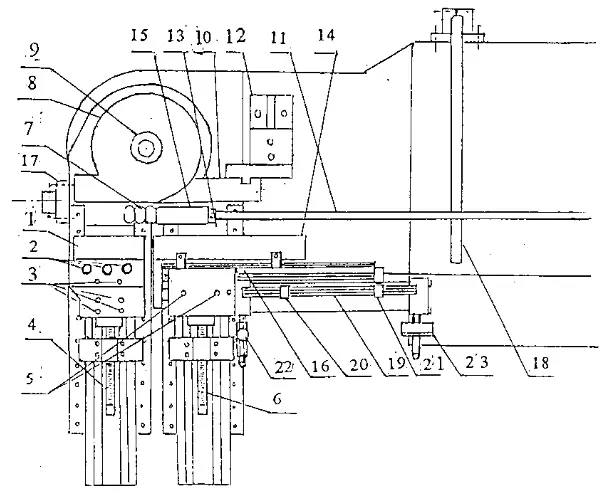
Lock the bending die and cap (9) in a clockwise direction, loosen and remove it. After replacing the required bending wheel die, lock the bending die and cap.
Installation of main clamping die
To replace the required clamping die, first, remove the pin shaft (2) of the main clamping die, replace it with the desired clamping die, and insert the pin shaft. Next, loosen the fixing bolt (3) of the clamping die base, operate the main clamp clamping using the manual mode screen, rotate the clamping die adjusting screw (4), and move it forward until the clamping die is clamped to the bending die. Then, press the main clamp to release the clamp and rotate the clamping die adjusting screw forward for 1/3 or 1/2 turn. Finally, lock the fixing screws of the clamping die base.
Installation of guide clamping die
To install the guide die, follow the same method as above, but adjust the clamping force to be slightly looser than that of the main clamping die.
If the pipe becomes wrinkled during bending, move the adjusting screw of the pressing die sleeve forward about 1/4 turn and then try bending again until there are no wrinkles.
During the bending test, it is important to ensure that the advance speed of the auxiliary pushing is synchronized with the bending speed.
Installation and adjustment of mandrel rod and mandrel cylinder seat
To install the mandrel bead (7), screw the mandrel rod (11) into the mandrel rod (15), and connect the mandrel to the cross joint of the mandrel cylinder.
The general adjustment method is to ensure that the front end of the mandrel rod exceeds the central tangent point of the bending die by 2-5mm (depending on the diameter of the bending die; the larger the diameter, the longer the distance beyond the tangent point, and the smaller the diameter, the opposite).
The mandrel cylinder seat should be installed on the guide rail of the mandrel cylinder, and the guide rail of the mandrel cylinder should be equipped with a scale.
The pointer indicates the radius of the bending die, so if the bending die is replaced, the mandrel cylinder seat should be adjusted accordingly.
Installation of anti wrinkle device
The wrinkle-resistant plate (10) is fixed on the wrinkle-resistant seat (12), with the arc seat of the wrinkle-resistant plate close to the bending die (8). The front end should be as close as possible to the center of the wheel die, and the rear end of the wrinkle-resistant plate should be parallel to the guide die with a difference of 1-2 degrees to reduce friction between the wrinkle-resistant plate and the workpiece.
Handling:
The entire machine tool can be lifted by threading steel wire through the bottom of the machine tool.
Cotton yarn or cloth should be placed at the contact point between the steel wire rope and the machine tool to avoid damaging the machine body surface.
During handling, the moving parts should be secured to prevent movement and collisions.
Installation:
The machine tool should be installed directly, and the equipment level can be adjusted by adjusting the damping sizing block at the foot of the machine tool.
The position of the oil cooler relative to the machine tool should be determined according to the actual operating position.
Preparation for commissioning:
Application in Power Generation Equipment Manufacturing:
The global demand for power generation equipment has significantly increased due to tightening resource supplies and rising energy costs. In this sector, CNC pipe benders play a crucial role, representing a substantial investment in the manufacturing process. These machines are essential for creating complex piping systems in power plants, including steam generators, turbines, and heat exchangers. Their precision and efficiency are critical in producing high-pressure pipes and intricate cooling systems, ensuring optimal performance and safety in power generation facilities.
Application in Mold Manufacturing Industry:
CNC pipe benders are integral to various stages of mold manufacturing, including forming molds, hot molds, cold molds, and plastic molds. Their versatility extends beyond traditional mold-making, with significant applications in automotive, railway, general machinery, and furniture manufacturing industries. These sectors rely heavily on pipe bending technology for creating precise, custom-shaped components and frameworks. The ability of CNC pipe benders to produce consistent, high-quality bends with minimal material waste has made them indispensable in modern industrial mold production.
Application in Aerospace Industry:
In aerospace manufacturing, pipe benders are crucial for shaping aircraft structural components. Historically, these parts were predominantly made from aluminum alloys and often large in volume. However, the increasing use of titanium alloys and composite materials in aerospace has led to more demanding requirements for CNC pipe bending machines. Modern aerospace pipe benders must handle these advanced materials with extreme precision, maintaining tight tolerances while minimizing material stress. They are used in creating fuel lines, hydraulic systems, and structural supports, where the integrity of each bend is critical for aircraft safety and performance. The evolution of pipe bending technology in this field continues to push the boundaries of material processing capabilities, enabling the production of lighter, stronger, and more efficient aircraft components.
The configuration of the hydraulic pipe bender is a crucial factor in determining its price. In the industrial machinery market, the adage “you get what you pay for” holds true, with each price point reflecting specific capabilities and quality levels.
Users requiring high bending accuracy and efficiency in hydraulic pipe benders prioritize quality, which is fundamentally determined by the machine’s internal components and design. Key factors influencing quality and price include:
For many customers, balancing cost considerations with quality requirements presents a significant challenge. This necessitates a thorough understanding of specific application needs, production volumes, and long-term ROI calculations.
Currently, the market offers a wide range of pipe benders, typically priced between 3,000 to 100,000 RMB (approximately $460 to $15,400 USD). Specific quotations depend on several factors:
When evaluating pipe bender options, it’s essential to consider not only the initial purchase price but also factors such as:
To achieve the desired geometric shape for the bent pipe, select the mold based on the pipe fitting’s outer diameter, wall thickness, and bending radius, and then adjust the corresponding parts.
Enter the required angle on the operation display screen according to the user’s needs (refer to the electrical appliance manual).
The pipe clamping and boosting of this machine tool adopts a connecting rod force-increasing mechanism.
To ensure the self-locking of the clamping state, first loosen the screw rods of the pipe clamp mechanism and the booster mechanism. Then, under the manual state, the two mechanisms are in the clamping position, and finally, tighten the screw rods.
The speed of the sliding block can be adjusted by the one-way throttle valve to synchronize it with the main shaft.
First, adjust the tailstock so that the center of the core rod coincides with the center of the die elbow, and then adjust the screw rod on the piston rod of the tailstock so that the core head extends to the appropriate position.
The following points should be observed when operating a pipe bending machine:
Pre-operation inspection:
Hydraulic system check:
Workpiece setup:
Die alignment:
Clamping verification:
Bending operation:
Post-operation procedures:
Emergency protocols:
Eight methods for pipe bender maintenance:
Method 1:
When operating the pipe bender, it must be strictly operated in accordance with the operating regulations (key points).
Regular maintenance of the machinery is necessary. The maintenance personnel must be qualified through education and training.
Method 2:
The pipe bender must be kept clean, and the unpainted parts should be coated with anti-rust grease.
Check whether the pressure of each oil pressure system is normal.
Method 3:
Before starting the pipe bender each time, lubricating oil should be added regularly at fixed points and quantitatively according to the requirements of the lubrication chart.
The oil must be clean and free of sediment.
The oil pipe and line of the bending arm should not touch the ground.
Method 4:
Regularly check and repair the switch, fuse, and handle to ensure their reliable operation.
Regularly check that the hydraulic oil in the oil tank reaches at least 80% of the oil level gauge.
Method 5:
The lubricating oil in the motor bearing shall be replaced and filled regularly, and the operation of the motor shall be checked regularly.
The temperature index of the oil level gauge should not exceed 60℃.
Method 6:
Regularly check whether the V-belt, handle, knob, and key are damaged. If they are significantly worn, they should be replaced promptly.
Regularly add lubricating grease at the meshing position between the transmission gear and the rack.
Method 7:
It is strictly prohibited for non-designated personnel to operate the equipment. In general, people must leave the machine and stop.
The sliding part or rotating part must be regularly lubricated.
Method 8:
Lubricate and clean the pipe bender 10 minutes before work every day.
When operating below 5℃, pay attention to the ponding and do not let it freeze.
Do not place magnetic objects near the servo motor or knock them.
When cleaning the LCD, please cut off the power first, and do not clean it with liquid detergent or liquefied vapor.
Do not place the machine in a location where there is rain leakage or humidity.
If oil leakage is found at the oil cylinder, confirm the need to replace the sealing ring.
If the machine pressure is found to be insufficient, please check whether the oil level in the oil tank is sufficient and whether the oil temperature is too high.
When the proximity switch is not sensed, the display screen will show the corresponding cause of the fault. Use the displayed fault information to locate the problem for maintenance and troubleshooting.
In case of an inaccurate angle, please check whether the claw cylinder moves forward and is in place, or check whether the corresponding claw is too large.
If the servo does not turn or the servo motor does not feed during operation, please check whether there is a fault code in the servo driver. The most common fault is a momentary low voltage. If experiencing the above conditions, turn off the main power supply first and restart it after 30 seconds. If it cannot be solved, please notify the company. Do not disassemble and repair without authorization, as you will be responsible for the consequences.
If the bending angle is not correct, please check whether the fixing screw of the encoder coupling is loose and whether the end slow bending has an input angle.
If any action of oil pressure fails to respond, please check whether the corresponding solenoid valve is abnormal.
For a comprehensive overview of leading industry players, we recommend consulting our detailed guide on the “Top 16 Pipe and Tube Bending Machine Manufacturers.” This resource provides in-depth information on each manufacturer, including their specialties, technological innovations, and market positioning.
When selecting a pipe bending machine supplier, consider factors such as:
By evaluating these criteria against your specific production requirements, you can make an informed decision on the best pipe bending machine supplier for your needs. Remember that the optimal choice may vary depending on your industry, production volume, and the complexity of your bending operations.
Selecting the appropriate pipe bending machine is crucial for efficient and precise manufacturing processes. Consider the following factors to make an informed decision:
By thoroughly evaluating these aspects, you can choose a pipe bending machine that not only meets your current production needs but also provides long-term value and efficiency for your manufacturing processes.

